Department of Ornithology
History
(until mid 20th century)
The most important basis for the research done at the Department of Ornithology is its rich collection obtained due to hard effort of many generations of zoologists. These are bird skins, alcohol specimens, skeletal and paleontological materials. The richness, diversity and completeness of the Department’s collection is the highest in Russia and one of the highest in Europe.
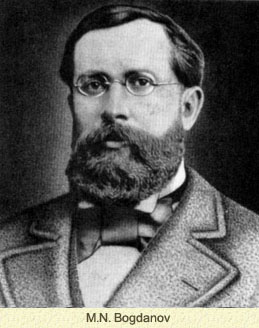
A great contribution to the foundation and expansion of ornithological collections was made by the first directors of the Zoological Museum Academicians Th.Th. Brandt and A.A. Strauch who organized special expeditions to different parts of Russian Empire and purchased specimens abroad. Of mid 19th century expeditions the following deserve to be mentioned: I.G. Voznesensky expedition to the Far East and Russian America, A.F. Middendorff expedition to East Siberia and N.A. Severtsov expedition to Turkestan. Especially important were the famous expeditions of N.M. Przewalski, P.K. Kozlov, G.N. Potanin and N.A. Zarudny to Central and Middle Asia, Mongolia, China, Iran. The rapid expansion of the collections was also facilitated by their first supervisors I.G. Voznesensky, A.F. Brandt and V.F. Russow. In 1882 when the Zoological Museum celebrated its 50th anniversary, the ornithological collection already contained over 24,000 specimens.
In 1879–1885, the famous zoologist Modest N. Bogdanov (1841–1888) was the collection’s supervisor. He started to identify the species meticulously and to make a collection inventory. A result of this work was his monograph ‘Shrikes of Russian fauna and allies’ (1881) which presented a review of the taxonomy of this complicated group and for the first time in Russian ornithological literature discussed intraspecific variation and species criteria on the basis of series of specimens. The first issue of the ‘Checklist of the birds of Russian Empire’ prepared by Bogdanov was published in 1884.
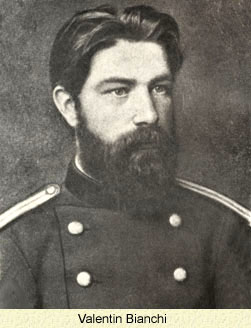
In 1886–1896, the Head of the Department of Ornithology was Academician Theodor (Fedor D.) Pleske (1858–1932). He pursued zoological research in the Kola Peninsula, the results of which were published in his ‘A critical review of mammals and birds of the Kola Peninsula’ (1887). Pleske revised the bulk of the ornithological collections brought by N.M. Przewalski expeditions. He published three issues of the series ‘Scientific results of the N.M. Przewalski expeditions to Central Asia’ (1889, 1890, 1894) including descriptions of avian species new to science. Special mention is deserved by five issues of the ‘Avifauna of Russian Empire’ (1889–1891) devoted to warblers, and a monograph on Arctic birds published in 1928 in Boston (USA).
In 1896–1920 the Head of the Department of Ornithology was Valentin L. Bianchi (1857–1920). Among his numerous ornithological studies, a number of superb monographs on avian taxonomy (snowcocks, pheasants, finches, larks, titmice, bullfinches, flycatchers etc.) deserve being mentioned. A series of publications was devoted by Bianchi to revision of collections brought from Middle and Central Asia, e.g. ‘The birds of Gansu expedition of G.N. Potanin 1884–1887’ (1891, co-authored by M.M. Berezovsky), 4th issue of the ‘Scientific results of the N.M. Przewalski expeditions to Central Asia’ (1905) and a voluminous ‘Materials for an avifauna of Mongolia and East Tibet’ (1907) based on the materials of the Mongolia – Sichuan expedition lead by P.K. Kozlov. The latter monograph includes a scheme of zoogeographic division of the Highland Asia Region. An important part of the scientific heritage of V.L. Bianchi is the first volume of ‘The fauna of Russia’ which was published as two semi-volumes in 1911 and 1913. Orders Gaviiformes and Procellariiformes was described in much detail. An important methodological publication of V.L. Bianchi is ‘Instruction for collecting birds, their eggs and nests’ (1909).
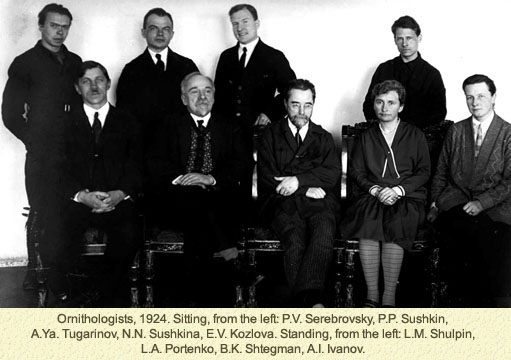
Especially important period in the history of the Department of Ornithology is 1921–1928 when it was lead by the Academician Petr P. Sushkin (1868–1928). He was a versatile specialist who worked fruitfully in all the main fields of ornithology: taxonomy, comparative anatomy, faunistics and ornithogeography. He also published on paleozoology and the origin of humans.
Sushkin gathered abundant collections and datasets on avian distribution and biology during his numerous expeditions to the steppes of Bashkiria and Kazakhstan, to the mountains of the Caucasus, southern Siberia and NW Mongolia. When analyzing his data he paid special attention to intraspecific variation and contributed much to the development of avian taxonomy. Sushkin’s work on the taxonomy of birds of prey and a number of passerine families belong to the most outstanding studies in avian taxonomy and phylogeny. His monograph on the birds of Altai (1938) is a classical example of a regional avifauna, including not only a review of physical geography of the study region, the data on systematics, distribution and biology of different species, but also general chapters devoted to zoogeographic analysis and the history of fauna. An important synthesis made by Sushkin in historical zoogeography is the monograph ‘Zoological regions of central Siberia and adjacent highland Asia and an attempt of a history of the recent fauna of Palaearctic Asia’.
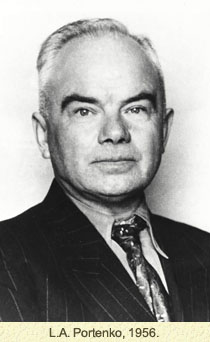
Perfect managerial abilities of P.P. Sushkin also became apparent during this period. The staff of the Department increased under his leadership: apart from B.K. Stegmann, positions were given to A.Y. Tugarinov and P.V. Serebrovsky; L.A. Portenko and later L.M. Shulgin pursued their Ph.D. studies, E.V. Kozlova started her studies. Much work was done with the collection; Sushkin specially developed methods of making inventory, storage and adding new items based of the experience of the world’s largest museums. The osteological collection and the collection of items stored in alcohol were growing especially quickly. The Department turns from a modest depository into one of the major centres of Soviet Union’s ornithology.
After P.P. Sushkin’s decease in 1928 his former students successfully developed scientific traditions laid down by him. Their studies in the fields of avian faunistics, ornithogeography, avian taxonomy and phylogeny shaped the highest level of such studies in the USSR and were acknowledged worldwide.
Pavel V. Serebrovsky worked at the Department of Ornithology in 1924–1942 and was the Head of the Department in 1928–1940. His research interests included ornithogeography, history of Palaearctic avifauna, influence of climate on evolution of birds, and subspecific variation. His most important publications were “The influence of climate on the evolution of birds” (1925), “New races of Palaearctic birds” (1927), “To the ornithogeography of Middle East” (1928), “Essays on the history of Palaearctic birds” (1937), “New avian species from Binagadin deposits” (1940).
Arkady Ya. Tugarinov (1880–1948) worked at the Department of Ornithology in 1926–1948 and was the Head of the Department in 1940–1948. He is mainly known as a first-rate student of Siberia’s avifauna. During 20 years he was the head of Krasnoyarsk regional museum, his numerous expeditions crossed the whole vast Yenisey basin. His first major work (co-authored by S.A. Buturlin) on the birds of the former Yenisey Gouvernement (1911) still remains a fundamental review. On the basis of two expeditions to Mongolia A.Y. Tugarinov made reviews of the northern and eastern parts of this country. He contributed volumes on waterfowl (1941), Pelecaniformes, Ciconiiformes and flamingo (1947) to the series “Fauna of the USSR”; he also wrote several chapters in the identification guide “The Birds of the USSR” (1951–1953).
A.Y. Tugarinov was the founder of systematic paleoornithological studies in Russia. He described the fossils of Neogene and Anthropogene birds found in Siberia, steppes of Ukraine, in Crimea and Kazakhstan. He made important contributions to the study of avian migration: he described wintering and migration of birds in western Caspian Sea and launched the scientific analysis of the Ringing Bureau dataset. He showed that ducks (e.g. Mallards and Pintails) have local populations with both distinct breeding areas and wintering grounds, using different flyways. Tugarinov initiated the first scientific meeting on bird migration held at the Zoological Institute in 1946.
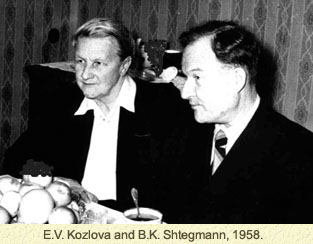
Elisabeth V. Kozlova (1892–1972) worked at the Department of Ornithology in 1932–1975. Her research interests were shaped under the influence of P.P. Sushkin. She started her way in ornithology by studying regional faunas. In 1923–1926 E.V. Kozlova participated in the expedition of the Geographical Society to Mongolia. She collected a unique dataset on the birds of this country and published in 1930 the book “Birds of southwestern Transbaikalia, northern Mongolia and Central Gobi” which was awarded by the Silver Medal of the Geographical Society. On the basis of the results of the two latter expeditions she wrote reviews on the birds of highland Hangai (1932) and eastern Kentei (1933); the results of Mongolian studies were published in the “Ibis”. The materials on the then little-known avifauna of Northern Mongolia Kozlova divided a large part of Central Asia into ornithogeographic districts and later made important conclusions in the historic zoogeography, summarized in her monographs “Avifauna of the Tibetan Plateau, its genetic relationships and history” (1952) and “The birds of zonal steppes and deserts of Central Asia” (1975). Kozlova published numerous and diverse papers on avian taxonomy and phylogeny. She wrote several chapters in the identification guide “The Birds of the USSR” (1951–1953) and three volumes of the series “Fauna of the USSR”, the two-volume review of waders being the most important (1961–1962). In this fundamental study Kozlova used the data of comparative and functional morphology, comparative ecology and biogeography to resolve the problems of waders’ taxonomy and phylogeny and showed the benefits of the combined biomorphological method in taxonomy.
The most part of the carrier of Leonid A. Portenko (1896–1972) was connected with the Department of Ornithology. He did his Ph.D. project here in 1926–1929, after which he worked at the Arctic Institute during 10 years. However, in 1940 he returned to the Zoological Institute and remained here until his death. The fields of Portenko’s research interests were determined during his study years under M.A. Menzbier and P.P. Sushkin and included avifaunistics, zoogeography and taxonomy.
During his work at the Arctic and Zoological Institutes, L.A. Portenko made long expeditions to zoologically little-studied and remote areas, like the Northern Urals, Novaya Zemlya, northern Taimyr, Anadyr area, Chukchi Peninsula, Wrangel Island, Koryak area, Kamchatka and Kuril Islands. He also made fieldwork in the Ukraine, Caucasus, in Kazakhstan and Middle Asia. The vast material collected during these expeditions was summarised in numerous publications, including the reviews of the bird of Podolia (1928), Transcarpathia (1950), monographs “Fauna of birds of non-polar parts of the Northern Urals” (1973), “Fauna of the Anadyr area” (1939, 1941), “The birds of the Chukchi Peninsula and Wrangel Island” (1972–1973). Due to the work of Portenko and his students the avifauna of Northeastern Asia is now one of the best studied ones within the former USSR. Portenko was able to confirm an important zoogeographical concept of the unity of the fauna of circumpolar tundra; he was an advocate of the single Holarctic zoogeographic region, with three subregions: Arctic, Palaearctic and Nearctic. Portenko also developed a scheme of ornithogeographic division of the whole USSR territory (1965) and of the regions. He compiled distribution maps of the birds from the USSR fauna in the first seven issues of “Altas der Verbreitung der paläarktischen Vögel” (Atlas of distribution of Palaearctic birds) published jointly by the Academies of Sciences of USSR and East Germany.
The main results of L.A. Portenko’s work in the field of avian taxonomy are reflected in the four-volume identification guide “The Birds of the USSR” (1951–1954) to which he contributed chapters on passerines and some other orders. In this publication Portenko aimed to study the intraspecific variation of the main diagnostic characters (colouration, size). Even though not all of his revisions stand the scrutiny of time (species were often treated by him too broadly, and genera – too narrowly), the importance of Portenko’s work for the development of avian taxonomy in the USSR was great.
Boris K. Stegmann (1898–1975) worked at the Department of Ornithology since 1921, first as a technician, and since 1928 as a research assistant. In 1934 he was awarded a D.Sc. in Biology summa cum laude. He was elected an honorary member of German, British and American Ornithologists’ Unions. He was expected to be elected a corresponding member of the Academy of Sciences of the USSR, but in 1938 he was arrested due to false charges and spent a year and a half in custody. The rehabilitation did not bring a complete freedom to him: soon after the Soviet Union’s involvement in the World War II in June 1941 Stegmann, like nearly all Soviet citizens who were ethnic Germans, was exiled from Leningrad and spent 1941–1946 in the delta of Ili river. It was a remote area in Kazakhstan, and Stegmann had to study the biology and commercial trapping of musk rat introduced in that region. After the end of his exile in Kazakhstan Stegmann was not accepted back as a researcher at the Department of Ornithology, but he regularly visited the department and continued his research.
Like his teacher P.P. Sushkin, Stegmann worked in many fields of ornithology: at first it was mainly avifaunistics, ornithogeography and subspecific taxonomy, later functional morphology, systematics of large taxa and phylogeny. His book “Basics of the ornithogeographic division of the Palaearctic” (1938) in which he developed a concept of fauna types and used a new method of zoogeographic mapping permitting to reflect the development history of faunas, was world-wide acknowledged. Stegmann concluded that the Palaearctic avifauna consists of seven related faunistic complexes (types of fauna), each having its own centre of origin and history. The main concepts of this classical work were included in many handbooks of zoogeography and ornithology.
Not less important are B.K. Stegmann’s works in the field of subspecific taxonomy, especially the review of forms of large gulls (1934) which was frequently referenced in reviews of evolution and speciation. The paper “On the functional meaning of subspecific characters in the Reed Bunting” (1948) is noteworthy because here Stegmann clearly showed the adaptive significance of subspecific characters.
Stegmann also made important contributions to the development of avian functional morphology and biomechanics. He made his studies in this field in the framework of large natural taxa (usually orders), mainly to the purpose of phylogenetical systematics. Stegmann based this phylogenetic constructions on the results of comparative studies of adaptive constructions of vital importance (e.g. the wing) and used functional analysis and the data on comparative ecology (e.g. the combined biomorphological method). As a result, he revised most orders of recent birds. The benefits of this approach are perfectly illustrated by Stegmann’s works on rails, corvids, doves, sandgrouses, divers (loons), grebes and waders (1952, 1955, 1957а, 1957b, 1958, 1968, 1974, 1978). His conclusion of the phylogenetic closeness of Galliformes and Anseriformes was later confirmed by DNA hybridization studies.
B.K. Stegmann paid a great attention to compiling user-friendly identification keys. “The short identification guide to the birds of the USSR”, co-authored by Stegmann and A.I. Ivanov, was published in two editions (1964, 1978) and is one of the best Russian-language guides of this kind.
Of faunistic publications of B.K. Stegmann one cannot but mention the review of the birds of the northern Baikal area (1936) and the volume of “The fauna of the USSR” devoted to the birds of prey. Of all Stegmann’s publications, large factual datasets and depth and originality of theoretical concepts, opening a wide perspective for new studies, are typical.
Alexander I. Ivanov (1902–1987) was the Head of the Department of Ornithology in 1949–1969, but his all research carrier since 1925 was connected with the Department. A.I. Ivanov did a lot of fieldwork as a participant of the Academy of Sciences’ numerous zoological and parasitological expeditions. He worked in Yakutia, southern Siberia, in the Far East, northern Kazakhstan and especially much in Middle Asia, also in Mongolia and South China. The results of these studies were published in a series of works on the fauna and systematics of Palaearctic birds. Most impressive is the large review of the birds of Central Yakutia (1929), the first one in the history of studying the birds of East Siberia, and two monographs on the birds of Tajikistan (1941) and Pamiro-Alay (1969). The latter book summarised the avifaunistic studies in a large Middle Asian highland and is packed with original factual information on avian distribution, biology and systematics. It is one of the best regional avifaunas.
The views of A.I. Ivanov as an avian taxonomist are most completely reflected in the works” “The birds of the USSR” (1951–1953), “The short identification guide to the birds of the USSR” (1964, 2nd ed. 1978), co-authored by B.K. Stegmann, and especially “The catalogue of the birds of the USSR” (1976). A.I. Ivanov edited and contributed to the bibliographic directory “Birds of the USSR” (1972, 1979, 1992). It was based on the directory of the ornithological literature started by F.D. Pleske and V.L. Bianchi. A.I. Ivanov also contributed the Russian-language ornithological bibliography to the “Zoological Record”.
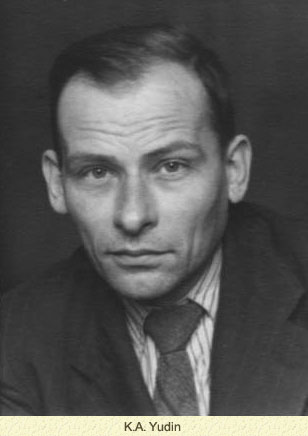
Konstantin A. Yudin (1912–1980) was the Head of the Department of Ornithology in 1969–1978. Yudin contacted the Zoological Institute as early as 1926 when he resided in Krasnoyarsk and started to collect Siberian birds. Scientific value and the high technical quality of his specimens sent to the Department of Ornithology impressed P.P. Sushkin. Correspondence with Sushkin and his publications governed the interests of Yudin. He started a systematic study of distribution and biology of the birds of Krasnoyarsk Territory. In 1944, Yudin started his Ph.D. study at the Zoological Institute. His thorough study of avian functional morphology, phylogeny and systematics started since then. A synthesis of data on comparative ecology, morphology and ontogenesis of falcons (Yudin’s Ph.D. thesis) allowed him to relate the anatomical characters with their biology, to demonstrate the adaptive significance of the “phylogenetic characters” and to identify the main stages of evolution of the living forms of falcons. This thesis which convincingly showed the superiority of the morphobiological approach to the avian systematics over the classical, phylogenetic one, was awarded by the P.P. Sushkin Prize.
Later K.A. Yudin developed and improved the combined morphobiological approach under the influence of ideas of A.N. Severtsov and I.I. Schmalgausen and brilliantly applied it to the phylogeny and classification of Charadiiformes, a large and complex order. Hew paid special attention to the comparative study of the adaptive structures of vital importance, mainly related to foraging and handling the prey, and to locomotion. The results of these studies are summarised in the publications “Cranium kinetism in gulls and alcids” (1958), “On the mechanism of mandible in Charadriiformes, Procellariiformes and some other birds” (1961) etc. In a finalising work “Phylogeny and classification of Charadriiformes” (1965) published as a volume in the “Fauna of the USSR” series, Yudin studied the ways of ecological specialisation within the order, the main evolutionary lines and phylogenetical ties of Charadriiformes with other avian orders. The fundamental work by Yudin “Biological significance and evolution of cranium kinetism in birds” (1970) is of primary importance for the understanding of evolution of the whole class Aves and their reptile ancestors.
K.A. Yudin actively participated in the development of theoretical and methodological problems of zoology. Of his publications on the subject, most noteworthy are the following ones: “On some fundamental and methodical problems of supraspecific avian systematics” (1970), “On the concept of ‘character’ and levels of development of animal systematics” (1974), “Classical morphological characters and the modern avian systematics” (1978). K.A. Yudin compiled a superb identification guide to procellariiforms of Antarctic and sub-Antarctic waters, and distribution maps of seabirds of the Atlantic and Indian Oceans. He did much to prepare highly qualified scientists and to plan and organize zoological research in the USSR.
References
- Banina N.N. 1962. Zoologist and ecologist Modest Nikolaevich Bogdanov. Proc. Inst. History of nature science and technics. Vol. 40. History of biol. Sciences. N 9: 292-301 (In Russian).
- Bannerman D.A. 1976. Elisabeth Kozlova. Ibis118: 594.
- Darevsky I.S., Loskot V.M. 1982. Ornithology and Herpetology Lab. In: Zoological Institute 150 years. Leiningrad, Nauka: 68-83 (in Russian).
- Fortunatov M.A. Boris Karlovich Stegmann (1898-1975). Proc. Inst. Biol. Inner Waters 31: 170-171 (in Russian).
- From letters of P.P. Sushkin to A.Ya. Tugarinov. 1950. In: In memoriam academician P.P. Sushkin. Moscow-Leningrad: 5-7 (In Russian).
- In memoriam A. Ya. Tugarinov. 1949. Izvestia A.N. Ser. Biol. N 1: 3-5 (In Russian).
- Ivanov A.I. 1952. In memoriam Valentin Lvovich Bianchi (30 years from decease). Proc. Zool. Inst. USSR Acad. Sci. Vol. 9. N 3: 957-963 (in Russian).
- Ivanov A.I. 1970. Petr Petrovich Sushkin. Proc. Zool. Inst. USSR Acad. Sci. Vol. 47: 5-8 (In Russian).
- Ivanov A.I. 1975. Student of Central Asia’s avifauna E.V. Kozlova. Proc. Zool. Inst. Acad. Sci. USSR 59: 249-250 (in Russian).
- Ivanov A.I. 1976. Elisabeth V. Kozlova. Ibis 118: 127.
- Ivanov A.I., Yudin K.A. 1963. Elizaveta Vladimirovna Kozlova (70th anniversary). Ornithologia 6: 493-494 (in Russian).
- Kozlova E.V. 1949. Creative life of Arkady Yakovlevich Tugarinov. Proc. Zool. Inst. Acad. Sci. USSR 8: 627-637 (in Russian).
- Kozlova E.V., Neufeldt I.A., Nekrasov B.V. 1974. Konstantin Alexeevich Yudin (60th anniversary). Ornithologia 11: 428-430 (in Russian).
- Kumari E. 1974. Leonid Alexandrowitsch Portenko 1896-1972. J. Ornithol. 115: 365-367.
- Kumari E. 1976. Boris Karlowitsch Stegmann 1898-1975. J. Ornithol. 117: 395-396.
- Mauersberger G. 1974. Zur Erinnerung an L.A. Portenko. Falke 21: 361-363.
- Nankinov D. 1973. Prof. L.A. Portenko. Priroda (Bulgaria) 22 (6): 91-92 (in Bulgarian).
- Neufeldt I.A., Yudin K.A. 1981. Contribution to science of Leningrad ornithologists E.V. Kozlova, L.A. Portenko and B.K. Stegmann. Proc. Zool. Inst. Acad. Sci. USSR 102: 3-33 (in Russian).
- Nowak E. 2000. Erinnerungen an Ornithologen, die ich kannte (2. Teil). J. Ornithol. 141: 461-500.
- Palmer R.S. 1973. Leonid Aleksandrovich Portenko. Auk 90: 487.
- Payevsky V.A. 2001. Science-operated fowlers. St. Petersburg. 147 pp (in Russian).
- Piechocki R. 1980. Elizaveta Vladimirovna Kozlova 1892-1975. J. Ornithol. 121: 419-420.
- Potapov R.L. 1988. In memoriam Alexander Ivanovich Ivanov. Ornithologia 23: 234-235 (in Russian).
- Skalon V.N. 1970. In memoriam Arkady Yakovlevich Tugarinov. Izvestia Irkutsk agriculture inst. N 26: 276-280 (In Russian).
- Stegmann B.K. 1948. A.Ya. Tugarinov. Proc.Alma-Ata reserve. N 7: 3-4 (In Russian).
- Stegmann B.K. 1972. Petr Petrovich Sushkin (1968-1928). To the 100th anniversary. Ornithologia 10: 408-419 (In Russian).
- Stegmann B.K. 2004. In the reedbeds of Pribalkhashie. Life and adventures of an exiled naturalist 1941-1946. Moscow, KMK Scientific Press 208 pp. (in Russian).
- Valentin Lvovich Bianchi. Obituary. 1922. Ibis. Ser. 11. Vol. 4. N 1: 188-189.
- Yudin K.A. 1974. Leonid Alexandrovich Portenko. Proc. Baltic Comm. Study Bird Migr. 8: 218-220 (in Russian).